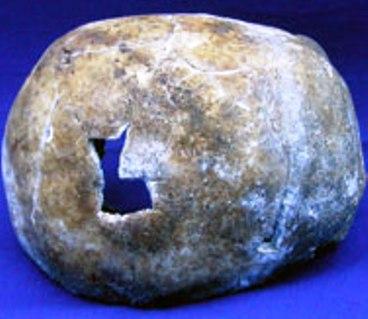Bronze Age Brain Surgeons
5,000 years ago, people living in Turkey were surprisingly good at what seems like a purely modern practice.
Will Hunt
Source - http://discovermagazine.com/2011/apr/08-bronze-age-brain-surgeons

The 4,400-year-old skull of an early neurosurgery patient. Ikiztepe archive
You might shudder at the mere thought of ancient brain surgery, but recent studies of the practice at Bronze Age sites in Turkey suggest that early neurosurgeons were surprisingly precise and that a majority of their patients may have survived.
At Ikiztepe, a small settlement near the Black Sea occupied from 3200 to 1700 B.C., archaeologist Önder Bilgi of Istanbul University has uncovered five skulls with clean, rectangular incisions that are evidence for trepanation, or basic cranial surgery. The procedure may have been performed to treat hemorrhages, brain cancer, head trauma, or mental illness. Last August Bilgi also unearthed a pair of razor-sharp volcanic glass blades that he believes were used to make the careful cuts.
There is ample evidence that Bronze Age sawbones knew what they doing. Last summer, biological anthropologist Handan üstündag of Anadolu University in Turkey excavated the 4,000-year-old trepanned skull of a man at Kultepe Höyük in central Turkey. üstündag says the surgeon cut a neat 1- by 2-inch incision, and “there are clear signs of recovery in the regrowth of bone tissue at the edges.” Judging from the frequency of healed bone in such skulls, anthropologist Yilmaz Erdal of Hacettepe University in Turkey recently proposed that about half of all Bronze Age trepanation patients—and 60 percent of those in Turkey—survived the procedure.

Evidence found of brain surgery 4,000 years ago
Source - http://www.todayszaman.com/news-217000-evidence-found-of-brain-surgery-4000-years-ago.html
Archeologists discovered an important cemetery on their first day of excavations in the Kaniş region.
The examination of a skeleton found during archaeological digs at Kultepe Höyük near the Kayseri-Sivas highway suggests that the Assyrian tradesman’s skull was opened 4,000 years ago to drain the cerebral cortex. Prof. Dr. Fikri Kulakoğlu from Ankara University Language-History-Geography Faculty archaeology division told the Anatolia news agency that teams excavating at the Kültepe-Kaniş-Karum area -- where digs have been going on since 1948 -- discovered a very important cemetery on their first day of excavations of the Kaniş region in 2010. They found the remains of an Assyrian tradesman, complete with his weaponry and personal belongings.
“The 4,000-year-old cemetery belongs to the Colonial Era, and alongside the skeleton, which likely belonged to a male Assyrian tradesman, we discovered personal belongings including a spear and an axe. An examination of his body yielded that a successful brain operation was performed on him before he died. We’re getting off to a good start to this year’s digs after this discovery, which has boosted our team’s morale,” Kulakoğlu said.
Anadolu University faculty member Dr. Handan Üstündağ noted that this was the first discovery of a skull of this kind. “Hundreds of skeletons have been found at Kültepe, but this one is different. There’s a very straight incision in his skull, 6 x 3 cm and traces indicate that the operation was completed successfully and that the patient healed after the procedure. This shows us that 4,000 years ago, a successful brain surgery was conducted: A drainage operation was performed and the patient’s recovery was ensured. We can see this plainly. Whoever did this was very experienced, and the operation was successful,” she said.